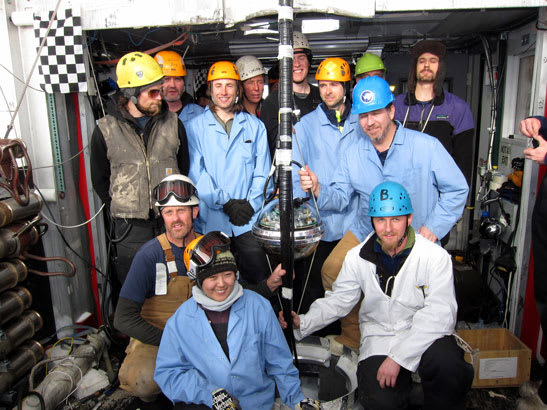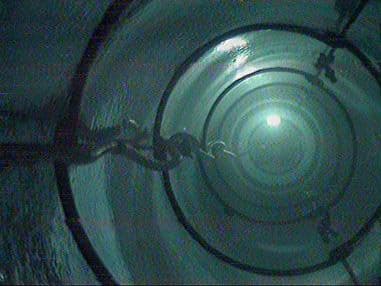
Highlights
The highlight of the week was the successful completion of major IceCube construction. The drilling of the 7th borehole of the season, the final hole of the IceCube array, was completed in the morning hours of December 18. The 86th and final IceCube string was tied off on Saturday, December 18, around 1800h New Zealand time.
Many IceCubers were in the tower to witness the moment the last Digital Optical Module (DOM) was sent on its journey 2450m under the surface of the ice. Many pictures were taken of the last DOM, that had been signed by most if not all team members at the Pole. Before the DOM was sent on down with a “3, 2, 1—DOMs away” short speeches were given in the tower by Prof Albrecht Karle (UW-Madison), Prof Per-Olof Hulth (Stockholm U.) and NSF program officers Vladimir Papitashvilli and Jim Whitmore.
After the string was secured, the group assembled outside the tower for a group photo with the completion banner. This day marks the successful completion of an eight year Antarctic construction effort. It was a memorable moment: the full IceCube Observatory with 86 strings and 81 IceTop stations has become reality.
On behalf of all IceCubers, thank you too all who sent congratulations and wished well.
Population and Deployments
South Pole Station Population is currently at 232, a decrease of 18 from the previous week. The current IceCube population stands at a count of 43 against a plan of 50, a decrease of eight from the previous week.
We took advantage of the excellent drilling pace to allow some people to leave to get home in time for Christmas. We currently have three people delayed in McMurdo and they will not be arriving until Tuesday, when flights to the South Pole resume. It was our intention to have more people leave on Saturday, Dec 18 but the only scheduled flight for the day was cancelled.
There are currently seven departures scheduled for Tuesday. The IceCube team enjoyed a very special day on Dec 18 when the final hole completed drilling and the final IceCube string was successfully deployed. There were many, many happy people here and I hope others were able to share in the moment though the WebEx videoconference. IceCube construction began eight years ago when the majority of the drill equipment was shipped to the South Pole. Over the last seven years, we deployed instrumentation into 86 holes. The first drilling season resulted in a single, but very important hole. Subsequent drilling seasons were 8, 13, 18, 19, 20 and finally, this year with seven.
Cargo is on schedule for IceCube. With the completion of drilling and deployment, the process of shipping cargo north (called ‘retro’) will begin in earnest.
Drilling
All members of the drill crew are in good health, no injuries, and high spirits. We started drilling the fifth hole (#1) on Dec 13th, sixth hole (#79) on Dec 15th, and the seventh and final hole (#80) was finished on Dec 18th,
The drill ran fine except with the usual small problems and generator issues, but all in all, the drill breezed through the last seven holes with few problems.
Next week we will transition over and start preparing the drill system for long term storage. We had three of our drillers head north this week, Terry Benson, Nate Bowker and computer specialist Matt Newcomb. We wished that they could have been here for the end of drilling because without them the project would not be nearly as successful.
Deployment

A very busy week culminating in the deployment of the 86th and final string. Three strings were deployed this week, spreading module attachment action around the clock – night, swing and finally, the day shift for the final string. Special devices — Askaryan Radio Array pulsers, the Dark Matter detector (DM-Ice) and the Swedish camera system were all successfully deployed.
Deployment of the final string started around 5.30am on Saturday morning New Zealand time. The Swedish camera team assembled and connected the system, which worked spectacularly from the start, providing amazing images from two cameras mounted several metres apart.
The general module attachment started around 7am. We went live to the world with a video Webex connection back to the collaboration. This allowed people to watch and ask questions of the team. We were also happy to entertain many visitors from the station throughout the day.
One highlight of the camera deployment was seeing an expected volcanic ash layer at about 300 metres deep in the ice with the camera system. Module attachment was completed after lunch, with a large crowd gathering to see the attachment and lowering of the final module, “Moa.” A couple of hours later everyone gathered again for the string tie-off, more photos and a group photo of all outside the tower to mark the occasion. Thank you to everyone who made this very long and busy day successful and safe!
Special devices and Optical Module Testing
The final week of IceCube deployment included the successful deployment of the second and third of the Askaryan Radio Array pulsers on the top and bottom of string 01.
We have also installed the second of the DM-Ice units at the bottom of string 79. The connections for both DM-Ice units (on strings 7 and 79) have been made into the IceCube Lab, and both detectors have been successfully turned on. We will continue to monitor the detectors as they freeze in, with data-taking starting in a few weeks after they have been frozen in.
The Swedish Camera was deployed at the beginning of string 80 and provided remarkable images during deployment. Laser illumination appeared to show freeze back of clear ice along the hole wall during the descent. Dust layers were clearly visible in the live images from the journey down the hole, and provoked much interest among the many people gathered for this last IceCube deployment.
The South Pole Acoustic Test System (SPATS) device was deployed after the tie-off of string 80. This device consists of two specially designed low noise sensors equipped with internal transmitters. The sensors were deployed on a special cable to depths of 350 m and 450 m in order to measure the acoustic noise in the South Pole Ice. The internal transmitters will allow the first studies of the effects of freeze-in on the acoustic signal, through comparison with laboratory calibrations.
This week saw the last of the DOMs leave the optical module testing area and head into the ice. DOM testing has now concluded and the testing area has been cleaned and cleared out. Much of the testing equipment will either be stored in the IceCube Lab or Retro’d.
Installation- IceTop
Station 81B was discovered to have a bad contactor. The contactor assembly removes the dissolved gasses from the water in order to produce clear ice. This is only the second time that a contactor has had to be replaced after tank filling. We were successful in the replacement procedure before freezing began. The tank is performing as expected now.
Sunshades were installed on the remaining tanks and opened them for freezing. On Wednesday, the University of Delaware hosted a “Call to the Deep Freeze”. Six schools from Delaware to Nebraska participated in the call. Each school asked two questions, one about the IceCube project and the next about life at the South Pole. Thanks to all the IceCubers who took the time to engage students and be part of the call.
The IceTop team also completed daily articles for the UD website from Dec. 1 to Dec. 16. Read more on IceTop activites at the UDaily.
Inside the IceCube Lab
All the surface cable connections are done! Much time was spent creating a reliable wet connector test in time to test String 79 and start the commissioning process within hours of deployment. Now we are focusing on organizing the lab and soliciting input on what to toss, retro, relocate.
The server replacement has been going very well over the past couple weeks, and we are almost finished. This week we did not replace a high number of machines, but the machines that were replaced took a lot of configuration and were very important. We have completed migration to the new one server.